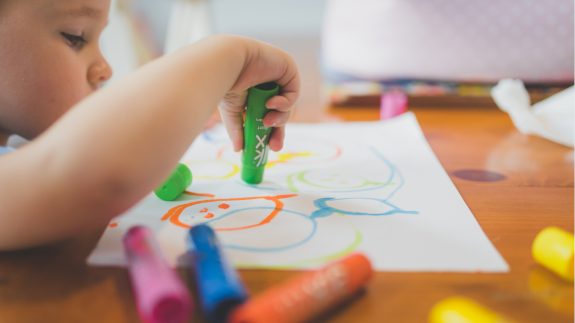Creating a Calming Routine: Tips for Managing Stress and Anxiety in Neurodivergent Children

Creating a Calming Routine: Tips for Managing Stress and Anxiety in Neurodivergent Children
October is Mental Health Month, making it an ideal time to focus on the well-being of neurodivergent children. For many children with conditions like Autism Spectrum Disorder (ASD), ADHD, or sensory processing disorders, managing stress and anxiety can require unique strategies. Creating a calming routine tailored to their needs can significantly enhance their sense of stability and comfort. In this blog, we'll explore how to develop a supportive routine and provide practical tips for neurodivergent children.
Understanding Stress in Neurodivergent Children
Neurodivergent children might experience stress and anxiety differently than their neurotypical peers. For example:
- Children with ASD may have heightened sensitivities to sensory input or changes in routine, leading to increased anxiety in unpredictable situations.
- Children with ADHD might struggle with maintaining focus and organisation, which can contribute to feelings of overwhelm and frustration.
- Children with sensory processing disorders can be easily overstimulated by their environment, causing stress that manifests through physical or behavioural symptoms.
Recognising these unique stressors is crucial for providing effective support.
The Power of a Consistent Routine
A structured routine can be particularly beneficial for neurodivergent children, offering predictability and reducing anxiety. Here are some tailored strategies for creating a calming routine:
- Visual Schedules: Use visual schedules or charts to outline daily activities. Neurodivergent children often benefit from clear, visual representations of what to expect, helping them understand and prepare for transitions.
- Consistent Sleep Patterns: Maintaining a regular sleep schedule is essential. Consider using a visual bedtime routine with specific steps to help your child wind down and understand what comes next.
- Structured Activity Blocks: Break the day into manageable chunks with clear start and end times. This can help children with ADHD or ASD stay focused and organised, minimising the stress of uncertainty.
Relaxation Techniques for Neurodivergent Children
Finding the right relaxation techniques can vary depending on individual sensory needs and preferences. Here are some adaptable methods:
- Sensory-Friendly Breathing Exercises: For children with sensory sensitivities, traditional deep breathing might not always be effective. Instead, try sensory-friendly alternatives like blowing bubbles or using a stress ball.
- Mindfulness with Adaptations: Introduce mindfulness practices that align with your child’s interests. For instance, if your child enjoys nature, you might practice mindfulness by listening to nature sounds or observing natural textures.
- Movement-Based Relaxation: For children with ADHD or high sensory needs, incorporating physical movement can be helpful. Techniques such as jumping on a trampoline, swinging, or engaging in rhythmic activities can be calming.
Play and Leisure: Finding What Works
Play is crucial, but neurodivergent children may have unique preferences or needs. Tailor playtime to their interests and sensory profiles:
- Sensory Play: Provide opportunities for sensory play that align with your child’s preferences. Activities like playing with kinetic sand, water play, or sensory bins can be soothing and engaging.
- Interactive and Physical Play: Choose activities that allow for movement and physical interaction. Games that involve jumping, running, or dancing can help manage excess energy and reduce stress.
- Calm Down Zones: Create a designated quiet space where your child can retreat when feeling overwhelmed. This space might include calming toys, soft textures, and dim lighting.
Supporting Your Neurodivergent Child’s Mental Health
Supporting your child’s mental health involves understanding and adapting to their unique needs:
- Respect Sensory Preferences: Be mindful of your child’s sensory sensitivities and preferences. Adapt the environment to reduce overstimulation and create a calming atmosphere.
- Communicate Clearly: Use clear, concise language and visual aids to help your child understand expectations and changes in routine. This can alleviate anxiety related to uncertainty.
- Promote Self-Advocacy: Encourage your child to express their needs and preferences. Teaching them to communicate what they need to feel calm and secure is empowering and can reduce stress.
When to Seek Professional Help
If your child’s stress or anxiety continues to be a challenge despite implementing a calming routine, seeking professional support may be beneficial. A child psychologist or therapist with experience in neurodiversity can provide tailored strategies and support.
Resources and Tools
Here are some resources that may be helpful for neurodivergent children:
- Books: Look for books that address sensory experiences or emotional regulation, such as “The Whole-Brain Child” by Daniel J. Siegel and Tina Payne Bryson, or “My Many Coloured Days” by Dr. Seuss.
- Apps: Explore apps designed for neurodivergent children, like Zones of Regulation or Breathe, Think, Do with Sesame, which can support emotional and sensory regulation.
- Websites: Visit websites like Autism Speaks or CHADD (Children and Adults with Attention-Deficit/Hyperactivity Disorder) for resources and strategies tailored to specific needs.
Conclusion
Creating a calming routine for neurodivergent children involves understanding their unique needs and implementing strategies that provide structure, predictability, and comfort. By using visual aids, adapting relaxation techniques, and tailoring playtime, you can help your child manage stress and anxiety more effectively. Remember, every child is different, so be patient and flexible as you find what works best for your family. If needed, don’t hesitate to seek professional guidance to support your child’s mental health journey.
Wishing you and your family a calm and supportive October!
Keep in touch!
Stay up to date with the latest news from All About Kids
© 2023 All About Kids. All Rights Reserved